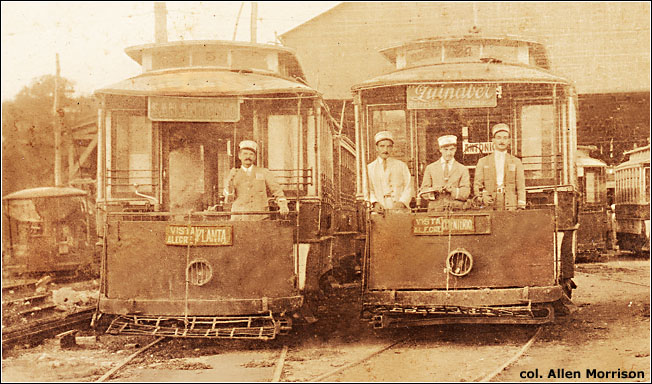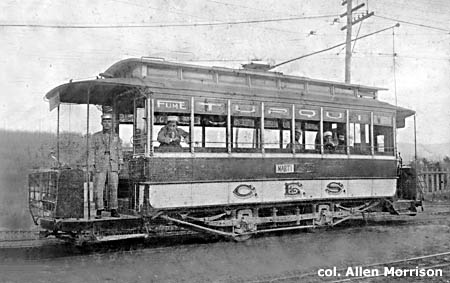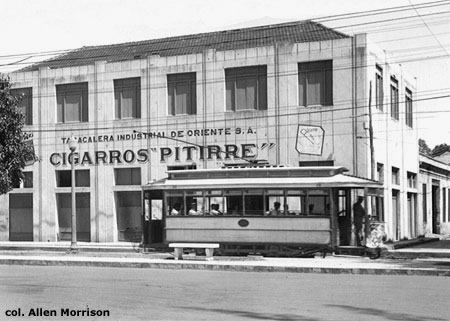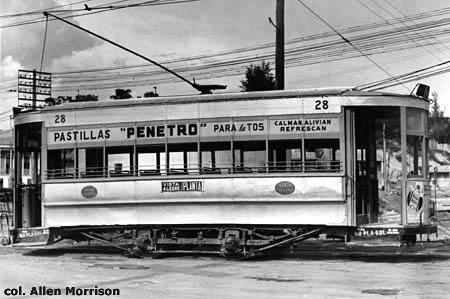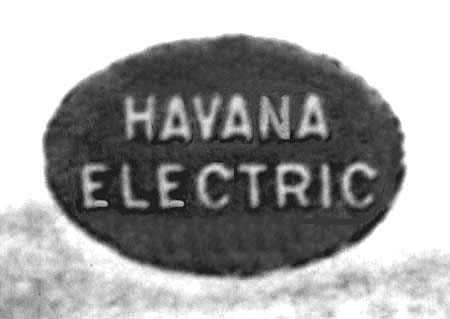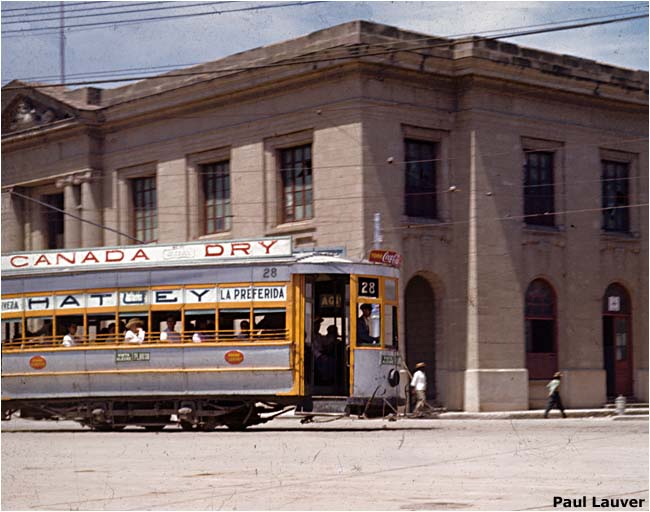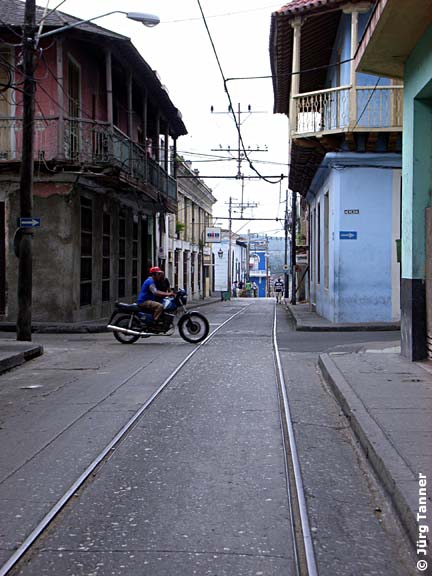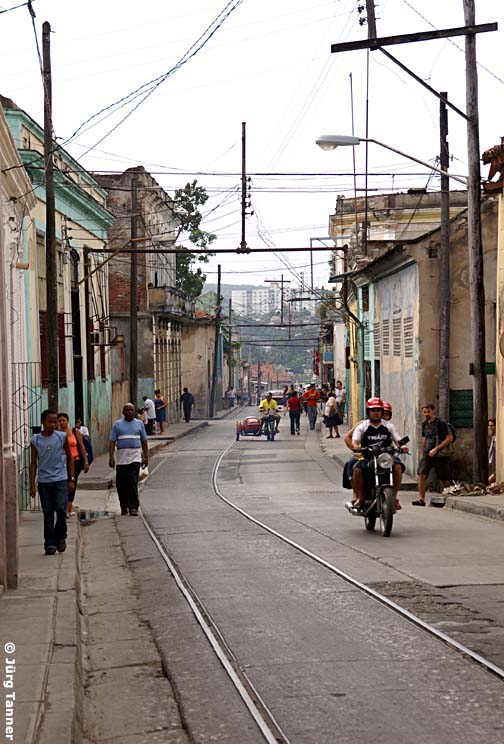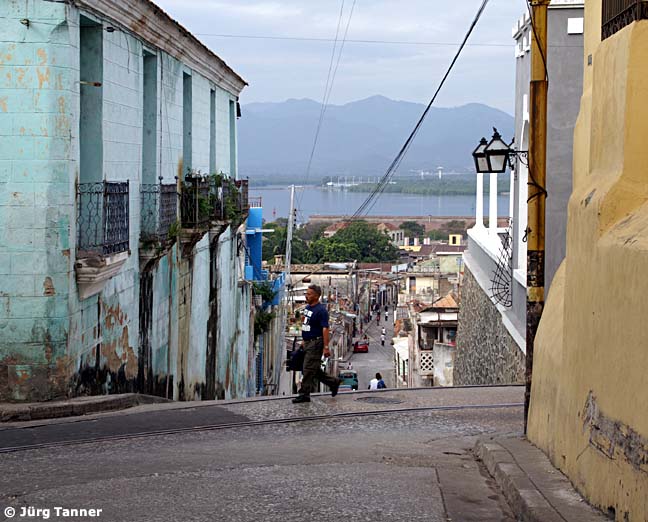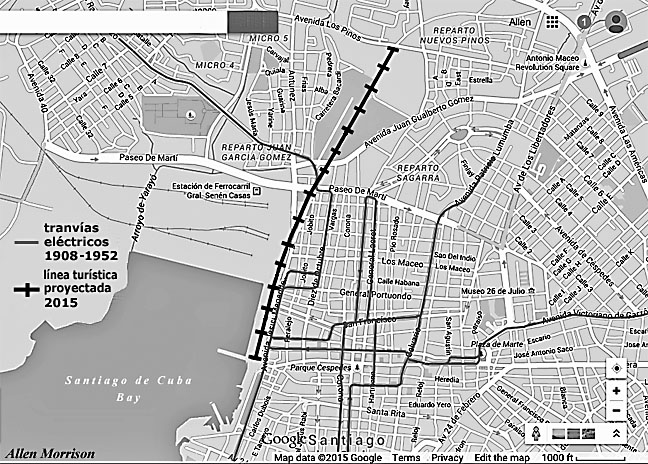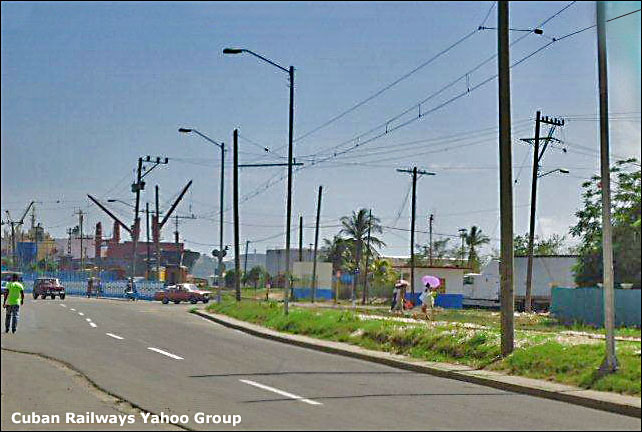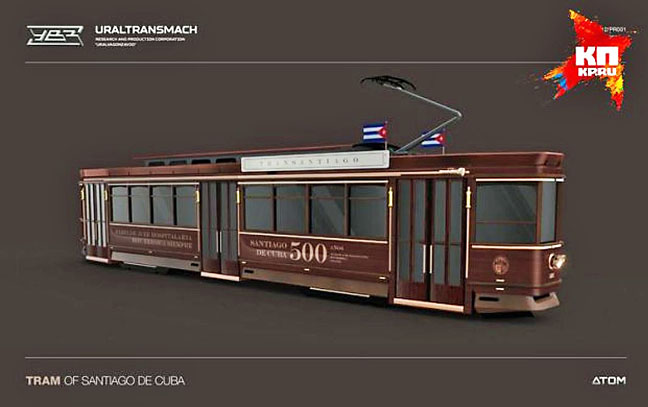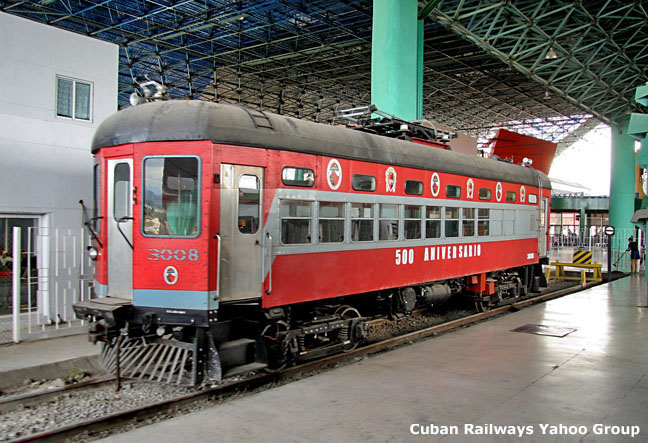The Streetcars of / Los Tranvías de
BY Allen Morrison
The Compañía Eléctrica de Santiago, registered in Cuba in 1904, began construction of an electric tramway in 1906 and ordered 14 streetcars with trolley poles from J. G. Brill Co. in Philadelphia on 1 March 1907. Each had a Brill model 21E truck. Passenger service from Vista Alegre to the electric plant ("Planta") was inaugurated on either 12 January or 8 February 1908 [see map]. Here is one of the original cars [col. AM].



The "Planta" (electric plant) and carbarn were located south of the city near the bay [see map]. Note the "San Antonio" boards [postcard, col. AM]: 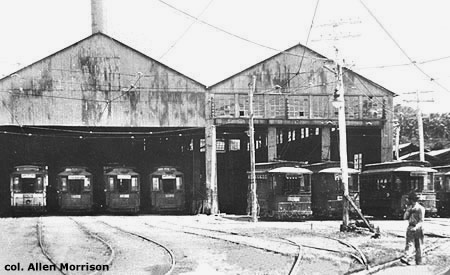
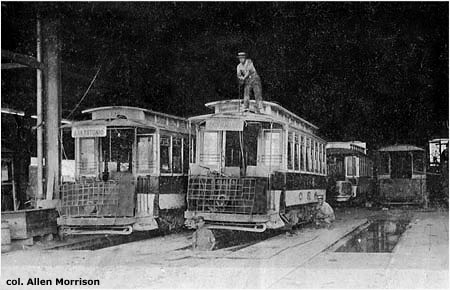
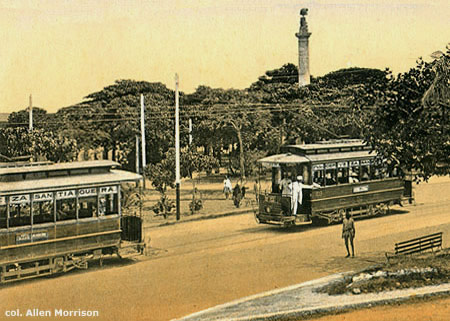
Car 28 in this photograph has nine side windows typical of Havana trams and was no doubt brought to Santiago from the capital. The single pole confirms its location. Note "Vista Alegre / PLANTA" board [see map] and two Havana plaques [col. AM]:
A closeup of the right-hand plaque [col. AM]:
The same tram number 28 (with different advertising) photographed in the late 1940s [Paul Lauver, col. Tom Lehman, from his flickr page; reproduced with Mr. Lehman's permission]:
Little is known of the system's development after 1940. Town histories ignore the tramway. Maps disagree. Many streets in Santiago changed their name several times in the 20th century – and have another name today. Names of the tram routes also changed and there were numerous "short turns". Because of its remote location few tram fans visited Santiago and photographs from the 1940s and 50s are rare. What happened to the system after Havana Electric Railway was sold to Autobuses Modernos in 1950? The only thing certain is that the Santiago tramway closed on 26 January 1952, three months before the system in the capital.
A half century later, many traces of the tramway remain. The following photograph, which shows how trams turned corners on narrow streets, was taken in 2002 by Ian Robinson of England. This is the junction of Calles Hartmann and Masó [see map] [Ian Robinson]:
The three pictures below were taken in April 2003 by Ray Gardiner of Australia. His fiancée, Yuselis, is looking south on Calle Hartmann [see map]. Note the steep grade [Ray Gardiner]:
The view below is north on Calle Padre Pico – where the trams jogged between Calles Robert and Sagarra [see map]. One can almost hear them chugging up this hill [Ray Gardiner]:
The following view is south along Calle Corona [see map]. Who can explain the track layout? Notice that motorists avoid parking on the streetcar tracks – even though they haven't been used in 51 years [Ray Gardiner]:
The next three photographs were taken in January 2008 by Jürg Tanner of Switzerland [Jürg Tanner]:
Note the heavy brackets over the street which once held the trolley wire. They can also be seen in other pictures on this page [Jürg Tanner]:
This must have been a very picturesque city – with a very picturesque tramway system – many years ago. That's Santiago de Cuba Bay in the distance [see map] [Jürg Tanner]:
There was an extraordinary development in 2015... As part of the celebration of its 500th birthday that year, the city demolished most of the abandoned rail yards along its waterfront and built a promenade and recreation park in their place. It saved 2 km of track that it planned to recycle as a tourist tram line [AM, based on Google Maps]:
Catenary
was strung over the rails. The
photograph below, taken on 22 August 2015, shows the grade crossing at
Paseo de Martí. The Villa Marimón tram line used to cross
here [see tramway map] [Cuban Railways Yahoo Group]:
Learning of the project, the Uraltransmach company in Yekaterinburg, Russia, submitted photographs of a model that it proposed to build for Santiago to help it celebrate its 500th anniversary [Uraltransmach]:
The inscription on the car in the doctored photo below – "Rebellious yesterday - Hospitable today - Heroic always" – is the official motto of the city of Santiago. But the cathedral in the background is in Havana [Uraltransmach]: 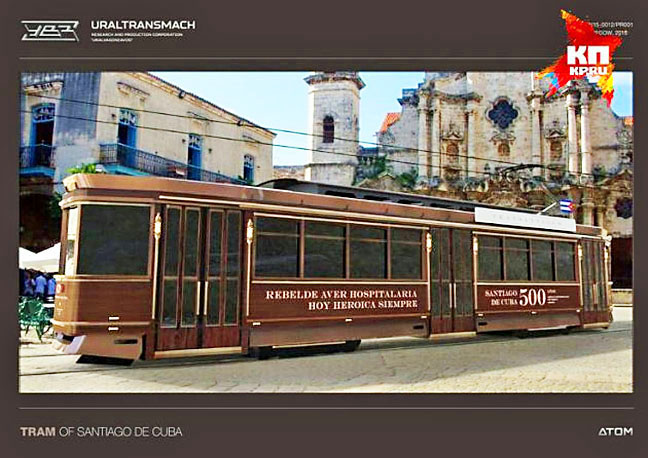 The price was too high and no trams were built (the vehicle shown above is a mock-up). Meanwhile, Santiago had acquired Brill interurban car 3008 from the Hershey railway in Havana Province, and refurbished and repainted it with the inscription "500 ANIVERSARIO" on both sides. It doesn't look much like the city's original Brill trams...but it was a nice try [Cuban Railways Yahoo Group]:
The car allegedly ran along 20 meters of Santiago's new electric railway on Thursday 23 July 2015. But that was all. It apparently never ran there again and in February 2016 was found in a shed, protected but unused, near the new Santiago railroad
station. It was returned to the Hershey system the next year and became "TRANS HERSHEY" again. See The Hershey Cuban Railway. An unknown number of electric cars that once ran on suburban lines in the Havana area – the Hershey system, Havana Central, Cuban Electric, Western Railway and United Railways of Havana, and which had been built by Brill, St. Louis Car, Cincinnati Car, Wason Manufacturing and American Car & Foundry – have been rebuilt with gasoline motors and still run today on rural lines throughout Cuba. Because of repeated alterations the origin of the vehicle below, photographed recently in Holguín province north of Santiago, cannot be determined [Cuban Railways Yahoo Group]:
Daniel Shvechkov. "Cuba asks Uraltransmach to supply trams through barter" in Radio Pravda, October 2015. Russian-language article about the Santiago de Cuba project. Six illustrations, including the two reproduced on this page. "Un histórico acuerdo refuerza la cooperación en defensa entre Rusia y Cuba" in RT, 9 December 2016. Confirmation that Russia and Cuba will cooperate on new projects, including tramways. In addition to Mr. Gardiner, the author would like to thank Camagüey resident Héctor Juárez Figueredo, Santiago de Cuba resident Santiago Carnago Muñoz, former Guantánamo resident Oscar Jalice and New York resident Yury Maller for the information that they provided about the tramways – past and present – of Santiago de Cuba.
INTRODUCTION & INDEX MAP If you have comments, additional information or photographs that might be added to this page, please write to Allen Morrison! Leo y escribo español. See my index of ELECTRIC TRANSPORT IN LATIN AMERICA This site was revised on 8 January 2017 Copyright © 2002-2102 Allen Morrison ALL RIGHTS RESERVED TODOS LOS DERECHOS RESERVADOS
|
